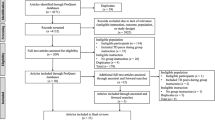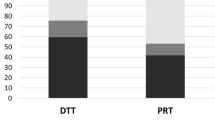Abstract
An essential goal for individuals with autism spectrum disorder (ASD) is to reach maximal independence on a variety of tasks that facilitate academic and vocational engagement and community integration. One-to-one instructional arrangements do not adequately prepare individuals with autism to function within various group contexts and limit opportunities for positive social interactions with one or more peers. Furthermore, group instructional formats have multiple benefits, including potentially increased instructional time and additional learning opportunities. The purpose of this pilot study was to evaluate the acquisition and maintenance of verbal behavior targets in individual and dyad instruction, as well as to compare levels of engagement across these instructional arrangements. Results suggest that three of the four participants acquired more targets during individual instruction, and three of the four participants maintained more targets within individual instruction. In addition, three of the four participants spent less time in instruction and more time on break during dyad instruction. These findings demonstrate the diversity of outcomes for dyad instruction for people with ASD. Directions for future research and suggestions for clinical implementation are provided.








Similar content being viewed by others
References
Elliot, C. D. (2007). Differential ability scales (2nd ed.). San Antonio, TX: The Psychological Corporation.
Favell, J. E., Favell, J. E., & McGimsey, J. F. (1978). Relative effectiveness and efficiency of group vs. individual training of severely retarded persons. American Journal of Mental Deficiency, 83(2), 104–109.
Glascoe, F. P. (2004). Brigance inventory of early development (2nd ed.). North Billerica, MA: Curriculum Associates.
Hammill, D. D., Pearson, N. A., & Weiderholt, J. L. (1997). Comprehensive test of nonverbal intelligence. Autism, TX: PRO-ED.
Johnson-Martin, N. M., Hacker, B., & Attermeier, S. M. (2004). Carolina curriculum for preschoolers with special needs (2nd ed.). Baltimore, MD: Paul H. Brookes Publishing Co., Inc..
Kamphaus, R. W., & Reynolds, C. R. (2007). Behavior assessment system for children (2nd ed.). Bloomington, MN: Pearson.
Kamps, D., Barbetta, P. M., Leonard, B. R., & Delquadri, J. (1994). Classwide peer tutoring—an integration strategy to improve reading skills and promote peer interactions among students with autism and general education peers. Journal of Applied Behavior Analysis, 27(1), 49–61. https://doi.org/10.1016/j.ridd.2014.08.021.
Kamps, D., Heitzman-Powell, L., Rosenberg, N., Mason, R., Schwartz, I., & Romine, R. S. (2016). Effects of reading mastery as a small group intervention for young children with ASD. Journal of Developmental and Physical Disabilities, 28, 703–722. https://doi.org/10.1007/s10882-016-9503-3.
Kamps, D., & Walker, D. (1990). A comparison of instructional arrangements for children with autism served in a public school setting. Education and Treatment of Children, 13(3), 197–216.
Kamps, D., Walker, D., Locke, P., Delquadre, J., & Hall, V. (1990). A comparison of instructional arrangements for children with autism served in a public school setting. Education and Treatment of Children, 13, 197–215.
Kamps, D., Walker, D., Maher, J., & Rotholz, D. (1992). Academic and environmental effects of small group arrangements in classrooms for students with autism and other developmental disabilities. Journal of Autism and Developmental Disorders, 22(2), 277–293. https://doi.org/10.1007/BF01058156.
Kamps, D. M., Dugan, E. P., & Leonard, B. R. (1994). Enhanced small group instruction using choral responding and student interaction for children with autism and developmental disabilities. American Journal on Mental Retardation, 99(1), 60–73.
Kamps, D. M., Leonard, B., Potucek, J., & Garrison-Harrell, L. (1995). Cooperative learning groups in reading: an integration strategy for students with autism and general classroom peers. Behavioral Disorders, 21(1), 89–109.
Kaufman, A. S., & Kaufman, N. L. (1983). Kaufman assessment battery for children. Circle Pines, MN: American Guidance Service.
Keel, M. C., & Gast, D. L. (1992). Small-group instruction for students with learning disabilities: observational and incidental learning. Exceptional Children, 58(4), 357–368.
Koegel, R. L., Egel, A. L., & Dunlap, G. (1980). Learning characteristics of autistic children. In Methods of instruction for severely handicapped students (pp. 259–301).
Ledford, J. R., & Wehby, J. H. (2015). Teaching children with autism in small groups with students who are at-risk for academic problems: effects on academic and social behaviors. Journal of Autism and Developmental Disorders, 45(6), 1624–1635. https://doi.org/10.1007/s10803-014-2317-1.
Lord, C., Rutter, M., DiLavore, P., & Risi, S. (1999). Autism diagnostic observation schedule. Los Angeles, CA: Western Psychological Services.
Newborg, J. (2005). Battelle developmental inventory (2nd ed.). Itasca, IL: Riverside Publishing.
Partington, J. W. (2006). The assessment of basic language and learning skills—revised. Walnut Creek, CA: Behavior Analysts, Inc..
Rodgers, T. A., & Iwata, B. A. (1991). An analysis of error-correction procedures during discrimination training. Journal of Applied Behavior Analysis, 24(4), 775–781.
Roid, G. H. (2003). Stanford Binet intelligence scales (5th ed.). Itasca, IL: Riverside Publishing.
Rotholz, D. A. (1990). Current considerations on the use of one-to-one instruction with autistic students: review and recommendations. Focus on Autistic Behavior, 5(3), 1–6.
Schopler, E., Reichler, J., & Renner, B. (1988). The childhood autism rating scale. Los Angeles, CA: Western Psychological Services.
Sindelar, P. T., Rosenberg, M. S., & Wilson, R. J. (1985). An adapted alternating treatments design for instructional research. Education and Treatment of Children, 8, 67–76.
Skinner, C. H. (2010). Applied comparative effectiveness researchers must measure learning rates: a commentary on efficiency articles. Psychology in the Schools, 47, 166–172.
Sparrow, S. S., Cicchetti, D. V., & Balla, D. A. (2005). Vineland adaptive behavior scales (2nd ed.). Minneapolis, MN: Pearson.
Sundberg, M. L. (2008). Verbal behavior milestones assessment and placement program: a language and social skills assessment program for children with autism or other developmental disabilities: Guide. Concord, CA: AVB Press.
Tekin-Iftar, E., & Birkan, B. (2010). Small group instruction for students with autism: general case training and observational learning. Journal of Special Education, 44, 50–63. https://doi.org/10.1177/0022466908325219.
Yaw, J., Skinner, C. H., Skinner, A. L., Maurer, K., Cihak, D., Wilhoit, B., … Booher, J. (2014). Measurement scale influences in the evaluation of sight-word reading interventions. Journal of Applied Behavior Analysis, 47, 360–379. doi:https://doi.org/10.1002/jaba.126.
Author information
Authors and Affiliations
Corresponding author
Ethics declarations
Ethical Approval
All procedures in studies involving human participants were in accordance with the ethical standards of the institutional and/or national research committee and with the 1964 Helsinki declaration and its later amendments or comparable ethical standards.
Informed Consent
Informed consent was obtained from all individual participants included in the study.
Conflict of Interest
The authors declare that they have no conflict of interest.
Electronic Supplementary Material
ESM 1
(DOCX 27 kb)
Rights and permissions
About this article
Cite this article
Croner, J.S., Smith, S.L., Woods, J.E. et al. A Pilot Investigation of Individual and Dyad Instructional Arrangements. Behav Analysis Practice 11, 115–128 (2018). https://doi.org/10.1007/s40617-018-0234-z
Published:
Issue Date:
DOI: https://doi.org/10.1007/s40617-018-0234-z




